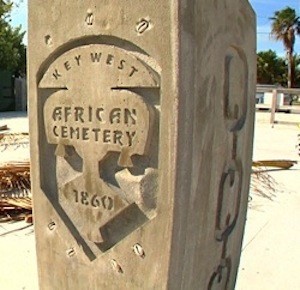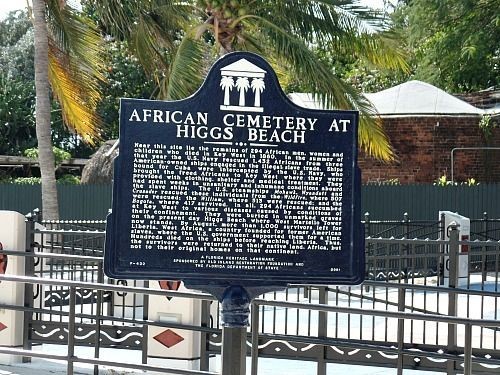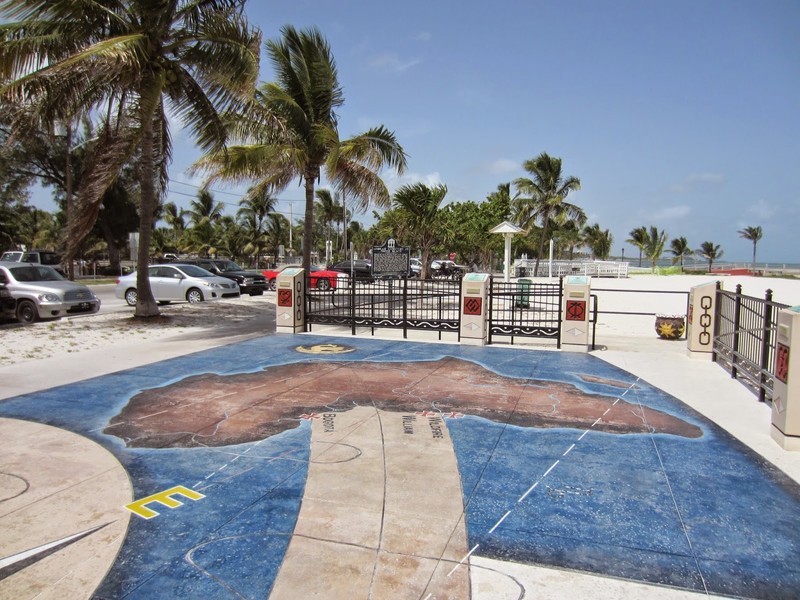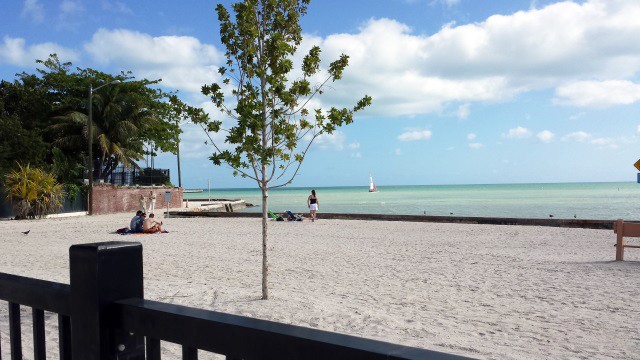African Cemetery at Higgs Beach
Introduction
Text-to-speech Audio
Images
One of the pedestals, decorated by African Adinkra symbols and finished with engraved bronze plaques

The Historic sign for Higgs Beach

An interpretation of the slave trade’s maritime route is displayed on a concrete base, while there is a tile mural in the platform riser.

The beach next to the African Cemetery is a beautiful place to relax by history.

Backstory and Context
Text-to-speech Audio
In 1860, three slave ships were interrupted on their way to Cuba and they were taken to Key West. Each ship came from different parts of the Western Coast of Africa and carried Africans, many of which were malnourished and clearly mistreated. The U.S. Navy had redirected these ships to Key West since it was illegal to transport slaves across the ocean as of 1820. Even though owning slaves was still legal, the maritime Slave Trade was not and the committed military worked hard to prosecute anyone that tried to break the ban. Once the ship was captured, the ban created confusion as to what to do with these Africans that were now considered to be illegal cargo. The community of Key West was shocked by the treatment of the human cargo, and so they worked hard to collect food and to provide shelter for almost 1,500 people that could have been sold into slavery but were now considered to be refugees. Unfortunately, many of the Africans were sick from living in disgusting conditions aboard the ship. The community tried hard to help and restore their health, but sadly 295 Africans had died while in Key West. They were buried as free people at Higgs Beach, where their skeletons would not be found again for almost 142 years.
The other free Africans that were able to survive were shipped to become apprentices in West Africa in an established colony. This was thanks to the US Congress in 1819, who had granted $100,000 toward the transportation of illegal slave trade back to Africa. Since the United States was greatly split on views over slavery, abolitionists were worried about the Africans' safety in the United States, while slave owners were worried about rebellion. As a result they wanted to send people back to Africa, causing a newly formed country, Liberia, where men and women were able to live out the rest of their lives in freedom and safety.
The African Cemetery actually wasn’t rediscovered until the summer of 2002. A team of archaeologists and volunteers worked together to conduct a Ground-Penetrating Radar survey, during which grids were laid out on the ground, and by using a hand-towed antenna, radar signals were produced and their reflections measured. By using the data that was gathered, they were able to locate evidence of the African Cemetery. Clear images of the subsurface structures showed a series of shallow graves near the sidewalk on the beach. There were additional researchers and archaeologists that had found at least one hundred more graves located further inland in 2010.
On September 16 2002, the Key West Africans’ Memorial Committee had coordinated a ceremony to dedicate the African Cemetery in remembrance. "Adegbolu Adefunmi, prince (now King) of the Yoruba African tribe in America, sprinkled water on the ground over the site while performing an ancient African ceremony honoring and remembering the dead" (African Burial Ground at Higgs Beach). He recognized and respected the refugees while a local minister led a group prayer.
Today, the site is a memorial that honors the African Burial Ground and is now listed on the National Register of Historic Places. The cemetery has been decorated to become more noticeable by an order of pedestals, decorated by African Adinkra symbols and finished with engraved bronze plaques. An interpretation of the slave trade’s maritime route is displayed on a concrete base, while there is a tile mural in the platform riser, along with ornamental fencing that surrounds the grounds on three sides. These decorations come together to create a representation of cultures of the people that were laid to rest, even though they were far from their home. Higgs Beach is a great place to visit and remember a sad chapter of this state’s history, as well as considering how far humanity has come. More information about the history and archaeological analysis details can be explored at an exhibit at the Mel Fisher Maritime Museum, located at 200 Greene Street in Key West.
Sources
"African Burial Ground at Higgs Beach." African Burial Ground at Higgs Beach. N.p., n.d. Web. 25 Feb. 2017.
"The Florida Keys & Key West." Key West's African Refugee Cemetery is Unique American Heritage Site. N.p., 02 May 2013. Web. 25 Feb. 2017.
"African Cemetery at Higgs Beach -." Key West Travel Guide. N.p., 21 June 2013. Web. 25 Feb. 2017.
